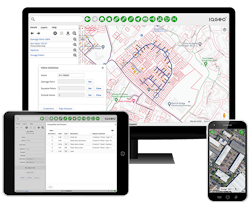Latest from Fiber Installation/Deployment
Fiber Velocity is Imperative; Talent is Elusive
Can the Right Technology Help with Both?
As the world moves increasingly online, the telecom industry has experienced an era of vision and innovation to keep up with technology evolution and consumer demands. The creation of super-fast fiber broadband promises to bring high-speed Internet to homes and offices to ensure Internet intensive activities can be performed from practically anywhere seamlessly. And 5G Internet will allow these activities to continue on the go.
The industry has made massive strides in creating the operational infrastructure they need to deliver universal broadband. Operators are beginning to create digital maps that field and office teams can use to integrate data from across the entire business, creating a complete network of assets that can be tracked and managed efficiently—a digital twin of their network. The Internet has become integral to everyday life and operators are evolving to meet new market demands and capitalize on revenue opportunities.
While telecom operators are embracing innovative technology that promises consumers great Internet performance, the key driver is the acceleration of fiber rollout. In the US, only 43% of households have access to fiber broadband. Similarly, only 53% of the US has 5G coverage depending on the provider. Improving technology is important to process optimization, but the business case is based on the rapid deployment of fiber to capture market share and maximizing revenue. It’s a velocity business proposition.
The same can be said for technology that will improve business operations. In the face of increasing weather-related disasters, operators need to use new technology to ensure that they have resilient networks, and can respond to disasters rapidly and efficiently. Innovation is accelerating network resilience and disaster response strategies to mitigate downtime. Greater network dependability reduces customer churn and secures long-term revenue targets. Here again, velocity is the driver.
There’s no time like the present to do this; a window of opportunity has opened up that telecom operators must seize. The COVID-19 pandemic has created new markets for telecom services. To adjust to lockdown life, many industries moved towards remote or hybrid working models, creating an increased need for Internet access within the home. Without the need to be in offices, many households moved out of cities in favor of more rural areas, meaning new locations for operators to service.
Furthermore, with Internet access moving from a luxury to a necessity for work, governments have set up initiatives to ensure that all households can have access. In the US, a $45 billion “Internet for All” initiative has been set up to ensure that every household in the country has access to reliable high-speed Internet. Similarly, across the pond, the EU is making efforts to reduce costs to provide Internet services to rural areas. Rapid execution is key. But how do operators get started?
Problem Solving and Implementation
While innovation has brought amazing new technologies to the telecom industry, it’s one piece of the puzzle. Operators who focus on active problem solving will be the ones who quickly bring real solutions to current and future industry challenges.
Telecom operators have markets to serve, the technology required, and the backing of governments to succeed in this mission. Now is the time for problem solving and action, moving from an era of vision and innovation into an era of implementation.
Below are three steps that will help telecom operators with this shift from their innovation phase to practical implementation.
1. Commit to building and nurturing a capable workforce
The backbone of any organization is its workforce and the telecom industry is no exception. To be successful in this space, it is important not only to focus on the innovation of technology to serve customer needs, but also to have a capable workforce of new and longstanding employees that can successfully implement and use this technology.
Moving into the implementation phase, organizations can benefit from a greater focus on the workforce. No employee wants technology thrust upon them. Organizations need to consult employees, as they will be the ones using this technology, involving them into the evaluation process to ensure they are already onboarded and support the new technology, and understand how to use it effectively.
In addition to training existing employees to use the latest technology, organizations can focus on hiring and retaining talent that will support these implementation objectives. According to McKinsey’s study on future workforce needs, 87% of organizations are either currently experiencing skill gaps, or are expecting to face this problem in the next five years. The study states that this is especially true within the telecom space. To add to this challenge, the wider tech industry is experiencing increased difficulty hiring new talent. Companies that make hiring the right talent a priority will create a more resilient and future-proof workforce.
This can be achieved by engaging the capabilities of the digital-native generation, leveraging and enhancing their competencies. For example, integrating all data into one digital place that can be accessed by the entire workforce—field, remote and office—caters to the strengths of Gen Z and Millennials, while also ensuring that vital information no longer lives in a silo. Democratizing technology and modernizing tools and systems ensures that the next generation of workers can rapidly meet their objectives.
2. Incrementally implement technology to efficiently and effectively solve problems
With a workforce that is capable of implementing technology and solving customer problems, operators should consider how this technology will be implemented as the next step.
Some may consider a “big bang” approach—drastically overhauling the current technology in favor of new and improved solutions. However, this is not the best path to active velocity. Operators often have to wait years until the technology is fully implemented. In an ideal world, implementation will have a 100% success rate. The reality, however, is that won’t always be the case, as some operators can spend valuable time and resources on an ineffective technological solution that has delivered marginal business benefits.
To reduce the risk of wasted resources and avoid losing market share to competitors, operators can instead implement technology rapidly but incrementally. By focusing on solving many smaller problems they can deliver short-term results with more agility, reducing the risks associated with the “big bang” approach. Rapid incremental implementations create a continuous stream of benefits and allows operators to consistently deliver value to customers and the business, encouraging future innovation.
This incremental method starts by identifying a specific area of the business that is experiencing an issue, and then implementing a targeted technology solution. For example, if the business is experiencing inefficiencies with field crews and contractors, operators can develop a new mobile solution for construction as a starting point. If what has been implemented proves to be effective, then it can be rolled out to other areas of the business experiencing issues or inefficiencies, gradually improving the business.
Operators with a holistic approach that lays a foundation across all operational areas will transform their business with a fast, low risk strategy.
“Some may consider a ‘big bang’ approach—drastically overhauling the current technology in favor of new and improved solutions. However, this is not the best path to active velocity.”
3. Follow in the footsteps of Brightspeed
US Internet provider Brightspeed is a great example of how operators can move from innovation to implementation by accelerating the planning and construction of their fiber optics network buildout.
To aid with the deployment of its network, Brightspeed is deploying a suite of fiber-based Optical Distribution Network (ODN) technologies, as well as integrated software that can leverage an innovative distributed tap product solution, to increase efficiency and accelerate the deployment process, thus increasing market availability. Implementing this innovative approach allows Brightspeed to expand its fiber optics network far quicker than if they had chosen to use a traditional centralized split design.
The telecom provider is expecting to reach up to 3 million homes and businesses over the next five years using its new strategy. This will include areas where fiber has not yet been deployed, thus efficiently accessing new larger markets.
Brightspeed was able to identify a pain point within their business and use a capable workforce to implement a new solution, thus allowing the company to capitalize on new markets. Other telecom organizations who follow in the footsteps of Brightspeed will be able to take full advantage of the window of opportunity currently available, entering into the era of high velocity deployments.

Jay Cadman | Senior Vice President Enterprise, IQGeo
Jay Cadman is Senior Vice President Enterprise, IQGeo. He has over 25 years of experience in successfully building B2B technology sales and marketing organizations. For more information, please visit https://www.iqgeo.com. You can follow them on Twitter: https://twitter.com/IQGeo_software and LinkedIn: https://www.linkedin.com/company/iqgeo/.






